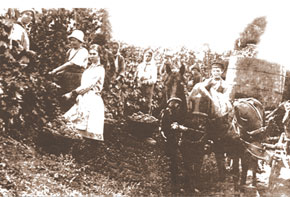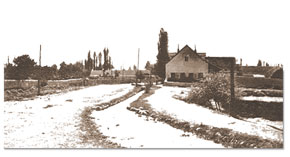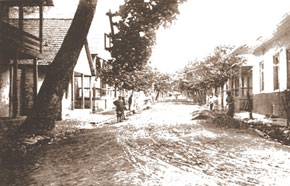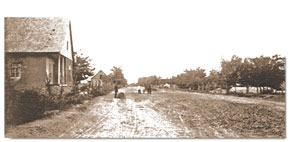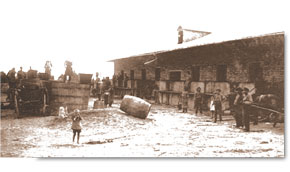 Pages 50-53
Pages 50-53by Rustam K. Alasgarov
The 19th century found Germany economically weak and politically split into a multitude of independent feudal dominions. These German lands had grand names – kingdoms, duchies, principalities, dukedoms, free towns and the estates of imperial knights.
The political map of Germany resembled a poor man’s patchwork quilt. As the economy suffered, so did the people. Crafts, trade, industry and arable farming were all struggling.
In the south of Germany was the Duchy of Wurttemberg – in one of the country’s most picturesque areas, where the Danube rises and the deep, quiet Neckar flows, where thick forests cloak the Swabian mountains and vineyards span the green hills, where France is just across the Rhine and Switzerland a stone’s throw away.
All the rulers of these mini states had great ambitions and the duke of Wurttemberg had more than most. He summoned renowned French and Italian architects, artists and actors to Wurttemberg. Castles and palaces were built and the court was known for its majestic celebrations and stunning fireworks. The duke’s subjects were left destitute by the gilded carriages, the mirrored walls in the Ludwigsburg opera theatre, the fur-trimmed uniforms of the hussars, and the luxury of the court. Craftsmen in the towns of Wurttemberg slid into poverty and the townspeople, the burghers, suffered too.
In 1805, the Duchy of Wurttemberg was pronounced a kingdom with the incorporation of South Baden, Alsace, part of Switzerland and part of Bavaria. The small dominions of Germany were marked by arbitrary feudal rule and despotism. German peasants were worn-out working the land of their masters and bedevilled by hardship. They had to survive failures in the harvest which came one after the other in the early 19th century.A particularly bad harvest and ensuing famine shook the German peasantry in 1816. Famine and poverty drove the landless peasants into the towns but there was no work for them in the underdeveloped industries.
Relations were complicated by religion and the Lutherans’ centuries-old confrontation with the Catholic Church. Lutheranism was strongest in the principalities of Saxony, Hesse-Darmstadt and Wurttemberg.
For the struggling people, only one way was left, however painful – emigration to distant countries, in search of work and bread. They left, taking with them their modest belongings, heading for the unknown, without speaking the language. Distant and mysterious America, Australia and, above all, Russia beckoned them.
Russian Empire beckons
Back in 1762 Tsarina Catherine II issued a Manifesto inviting settlers to come to Russia to claim the extensive lands in the empire. “Our royal loving kindness and benevolence will be bestowed on all who come to settle in Russia...,” she pledged.
A more detailed manifesto, issued the following year, specified that self-governance, exemption from military service, tax exemption for 30 years and full freedom of religion were guaranteed to settlers from Europe.
The manifesto soon attracted attention abroad. In 1781, 11,799 dessiatinas (12,890 hectares) of land in the ancient town of Kizikerman (since 1748 the city of Berislav, now in Ukraine) were allotted to Swedes, who had previously lived on the island of Dago (Hiiumaa island in Estonia) and were subjects of the Russian Empire. Among these settlers were 14 German families. They were the first formal colonists in Russia. Russia was not too far away and was familiar, thanks to the dynastic marriages of the Russian royal house with German princesses. For example, Tsar Alexander I was the son of Sophia Dorothea, princess of Wurttemberg. The Wurttemberg people who left their home country, willingly responded to the tsar’s promise to help German emigrants settle down, provide them with land, exempt them from military service and state taxes and guarantee full religious tolerance.
Finally, in September 1816, 40 families of the Protestant community from Schweinheim in Waiblingen, northern Bavaria, accepted Alexander I’s offer and, led by Gottlieb Lefler and Adam Schuler, gathered in Ulm, from where they set off for the East, nurturing their dream of settling in the wild, unknown Caucasus. In Germany the Swabians made wine, so they looked for somewhere that they could continue this trade successfully. A German proverb says: “Jedes Land ist dem Menschen ein Vaterland” (“Any land is a man’s fatherland”). The Swabians travelled to the East, to a bright future in the vast land of Russia. The promised material and financial help from Russia would buy horses and a good cart, and clothes and food for the long journey. In 1817 and 1818, over 1,400 families were recruited for the “great mission”, 6,000 people in all.
After all of those willing to leave Wurttemberg gathered, the settlers were divided into groups and columns, and each family was to keep strictly to the place assigned to them in the column. After a long chain of wagons was built, the column slowly started to move, heading east. Both a government commissar and a selected representative from among the settlers were appointed to be in charge of the columns.
A more detailed manifesto, issued the following year, specified that self-governance, exemption from military service, tax exemption for 30 years and full freedom of religion were guaranteed to settlers from Europe.
The manifesto soon attracted attention abroad. In 1781, 11,799 dessiatinas (12,890 hectares) of land in the ancient town of Kizikerman (since 1748 the city of Berislav, now in Ukraine) were allotted to Swedes, who had previously lived on the island of Dago (Hiiumaa island in Estonia) and were subjects of the Russian Empire. Among these settlers were 14 German families. They were the first formal colonists in Russia. Russia was not too far away and was familiar, thanks to the dynastic marriages of the Russian royal house with German princesses. For example, Tsar Alexander I was the son of Sophia Dorothea, princess of Wurttemberg. The Wurttemberg people who left their home country, willingly responded to the tsar’s promise to help German emigrants settle down, provide them with land, exempt them from military service and state taxes and guarantee full religious tolerance.
Finally, in September 1816, 40 families of the Protestant community from Schweinheim in Waiblingen, northern Bavaria, accepted Alexander I’s offer and, led by Gottlieb Lefler and Adam Schuler, gathered in Ulm, from where they set off for the East, nurturing their dream of settling in the wild, unknown Caucasus. In Germany the Swabians made wine, so they looked for somewhere that they could continue this trade successfully. A German proverb says: “Jedes Land ist dem Menschen ein Vaterland” (“Any land is a man’s fatherland”). The Swabians travelled to the East, to a bright future in the vast land of Russia. The promised material and financial help from Russia would buy horses and a good cart, and clothes and food for the long journey. In 1817 and 1818, over 1,400 families were recruited for the “great mission”, 6,000 people in all.
After all of those willing to leave Wurttemberg gathered, the settlers were divided into groups and columns, and each family was to keep strictly to the place assigned to them in the column. After a long chain of wagons was built, the column slowly started to move, heading east. Both a government commissar and a selected representative from among the settlers were appointed to be in charge of the columns.
Long road
The Swabians gathered not far from Stuttgart to set off for the Caucasus. They journeyed along the Danube through the territory of Austria and the Ottoman Empire, via Vienna, Belgrade and Izmail at the mouth of the Danube. They travelled to the city of Odessa in the Russian Empire and from there along a fixed route to the South Caucasus.
Disease beset the people of Wurttemberg as they travelled the long, dusty road across Europe. By the time they reached Russian territory, 1,200 of the settlers had lost their lives to disease. Sometimes whole families died and only half of those who left Wurttemberg reached Odessa. From Odessa there was still a long way to go.
The first column of selers, which was led by Friedrich Fuchs and consisted of over 40 Schweinheim families, arrived relatively safely at the Grossliebental colony which had been established not long before near Odessa. Some of the newly-arrived settlers, about 10 families, chose to stay and founded the colony of Hoffnungstal, not far from Grossliebental. The rest of the settlers had not given up their hopes for the Caucasus and continued the long journey. Some settlers stopped along the way, founding colonies in Bessarabia, Tavria, and Herson. The rest continued to the Caucasus, along the route Herson – Taganrog – Rostov – Georgiyevsk – Stavropol – Mozdok and Tiflis (Tbilisi). Not far from Anapa on the north-east coast of the Black Sea another small German colony was set up.
The Russian government had allocated each family a horse, a cart and travel expenses of 148 rouble 85 kopecks in silver.
This helped them on their way, but did not spare them hardship. It took the settlers two and a half months to travel from Odessa to the Caucasus.
Disease beset the people of Wurttemberg as they travelled the long, dusty road across Europe. By the time they reached Russian territory, 1,200 of the settlers had lost their lives to disease. Sometimes whole families died and only half of those who left Wurttemberg reached Odessa. From Odessa there was still a long way to go.
The first column of selers, which was led by Friedrich Fuchs and consisted of over 40 Schweinheim families, arrived relatively safely at the Grossliebental colony which had been established not long before near Odessa. Some of the newly-arrived settlers, about 10 families, chose to stay and founded the colony of Hoffnungstal, not far from Grossliebental. The rest of the settlers had not given up their hopes for the Caucasus and continued the long journey. Some settlers stopped along the way, founding colonies in Bessarabia, Tavria, and Herson. The rest continued to the Caucasus, along the route Herson – Taganrog – Rostov – Georgiyevsk – Stavropol – Mozdok and Tiflis (Tbilisi). Not far from Anapa on the north-east coast of the Black Sea another small German colony was set up.
The Russian government had allocated each family a horse, a cart and travel expenses of 148 rouble 85 kopecks in silver.
This helped them on their way, but did not spare them hardship. It took the settlers two and a half months to travel from Odessa to the Caucasus.
Georgia
In September 1817, 178 German settlers reached Tiflis. Some 35 kilometres from the city, they began to set up the first German colony in the South Caucasus, Marienfeld. In August 1817, another group of settlers from Wurttemberg left Ulm for the Caucasus. The new group followed the same route as the first convoy, which had been chosen by the Russian government. As before, many died from disease during the journey. In December 1817, some 300 families joined previous settlers at the new colony of Hoffnungstal near Odessa. Another 500 families continued their journey to the South Caucasus. The settlers were provided with horses and carts for their journey from Odessa to Tiflis. Each family received 500 roubles, two roubles per person a day for travel expenses and 40 kopecks for food. This was a good sum at the time. Cossack troops were assigned to guard the convoys as they wended their way to Tiflis. The Tiflis department for settlement had in the meantime developed a plan under which the arriving colonists were divided into six settlements. As a result, more new colonies were formed near Tiflis – Marienfeld, Elisabethtal, Alexandersdorf and Neu–Tiflis. The colony of Katharinenfeld appeared later, as did other smaller German settlements, Alexandershilf (1860), Valdheim (1906), Traubenberg (1908), Georgstal (1910), Marxheim (1914), Weisendorf (1921), and Steinfeld, Gruntal, and Hoffnungstal (1922). The names of the settlements changed often, in line with the political system of the day.
Azerbaijan
Settlers from the sixth and seventh convoys established the colony of Annenfeld. The eighth, ninth and tenth groups, who were led by Golieb Koch, Jakob Kraus and Johannes Wucherer respectively, were tasked with building a new colony 177 km east of Tiflis near the town of Yelizavetpol (Ganja). The Swabians in the last columns may not have been too happy, as they wanted to sele near their own people not far from Tiflis.
In the cold December of 1818, the first settlers’carts entered Yelizavetpol accompanied by Cossacks. They were allotted land – plots that stretched along the banks of the river Ganjachay. Russia’s military governor in the Caucasus, Gen Yermolov, ordered that the Germans be shown respect and be settled in safe places.
It was wintertime, and local people welcomed the settlers into their homes, until they could start to build their colonies. As the warmer weather came in 1819, the Wurttemberg people moved to the land they had been allotted. They lived from hand to mouth, in the unaccustomed heat of summer and in unfurbished dugouts in winter, fighting off wild animals and sometimes even falling victim to them.
The German colonists cleared the land, planted vegetables, and built houses with their own hands, as their loans were not enough to buy tools.
Eight kilometres from Ganja, the first new German colony was set up near the abandoned village of Xanliqlar. The settlers moved there on Easter Tuesday, 1819, after nearly two years of travel. The German colony was named Helenendorf (Helentenor) in honour of Tsar Paul I’s daughter, Grand Princess Yelena Pavlovna, the grand duchess of Mecklenburg–Schwerin, who died young. (Helendorf is now the town of GoyGol.) Initially, there were 127 families or 501 people in the colony.
A year later, in 1820, a second German colony was set up in the Yelizavetpol governorate – Annenfeld – 40 km from Helenendorf, on the southern side of the Shamkir fortress (now the town of Shamkir). The Germans became well-established in Azerbaijan. Archive documents confirm that they made a considerable contribution to the development of the economy of the area and of the entire region.
Rustam K. Alasgarov is a member of the State Historical Archive of the Azerbaijan Republic and deputy chairman of the National Revival Cultural Society of Germans of Azerbaijan.
In the cold December of 1818, the first settlers’carts entered Yelizavetpol accompanied by Cossacks. They were allotted land – plots that stretched along the banks of the river Ganjachay. Russia’s military governor in the Caucasus, Gen Yermolov, ordered that the Germans be shown respect and be settled in safe places.
It was wintertime, and local people welcomed the settlers into their homes, until they could start to build their colonies. As the warmer weather came in 1819, the Wurttemberg people moved to the land they had been allotted. They lived from hand to mouth, in the unaccustomed heat of summer and in unfurbished dugouts in winter, fighting off wild animals and sometimes even falling victim to them.
The German colonists cleared the land, planted vegetables, and built houses with their own hands, as their loans were not enough to buy tools.
Eight kilometres from Ganja, the first new German colony was set up near the abandoned village of Xanliqlar. The settlers moved there on Easter Tuesday, 1819, after nearly two years of travel. The German colony was named Helenendorf (Helentenor) in honour of Tsar Paul I’s daughter, Grand Princess Yelena Pavlovna, the grand duchess of Mecklenburg–Schwerin, who died young. (Helendorf is now the town of GoyGol.) Initially, there were 127 families or 501 people in the colony.
A year later, in 1820, a second German colony was set up in the Yelizavetpol governorate – Annenfeld – 40 km from Helenendorf, on the southern side of the Shamkir fortress (now the town of Shamkir). The Germans became well-established in Azerbaijan. Archive documents confirm that they made a considerable contribution to the development of the economy of the area and of the entire region.
Rustam K. Alasgarov is a member of the State Historical Archive of the Azerbaijan Republic and deputy chairman of the National Revival Cultural Society of Germans of Azerbaijan.
LITERATURE
Acts collected by the Caucasus Archaeological Commission, Т– VI – Тiflis 1874. Part 1, p. 248.
Kavkazskiy calendar (Caucasus Calendar), 1856, 1888, 1897, 1905, 1910 .
State Historical Archive of Azerbaijan: Collection 508, Catalogue 1, File 20, pp. 57–59
Ibid. File 75, p. 778
Ibid. File 371, p. 3
Ibid. File 436, pp. 23–24
Photos Yermakov.
Taken before 1900
Photos from Azerbaijan State Cinema-Photo
Documentary Archive
Kavkazskiy calendar (Caucasus Calendar), 1856, 1888, 1897, 1905, 1910 .
State Historical Archive of Azerbaijan: Collection 508, Catalogue 1, File 20, pp. 57–59
Ibid. File 75, p. 778
Ibid. File 371, p. 3
Ibid. File 436, pp. 23–24
Photos Yermakov.
Taken before 1900
Photos from Azerbaijan State Cinema-Photo
Documentary Archive
